Dingoes in NSW are in need of adoption — although dingoes are an Australian native animal, they are widely persecuted — literally hunted down, trapped, shot, or inhumanely poisoned. This means dingoes become displaced and orphaned and in need of homes. In addition, many dingoes who are born through backyard breeding ultimately end up surrendered and in need of rescue.
Today I’d like to introduce two very special dingoes in NSW, Phoenix and Noah, as well as their guardian/dingo mum, Lisa. Phoenix is a wild-born dingo who was found alone, malnourished and covered in ticks at a farm in NSW. She spent almost three years at a rescue before finding a home with Lisa and her family. Noah was bred in captivity through a breeder and sold to individuals who were unprepared for the unique needs of a dingo. This family surrendered Noah and he lived at rescue for six years. Both Phoenix and Noah have found a home in suburban NSW with a very patient and caring family.
This is a long read, but an important one — it’s the story of many dingoes across Australia.
If you’re looking for specific information about dingo adoption in NSW or dingo behaviour, you can jump head to specific part in Pho and Noah’s story:
- Building a dingo enclosure at home
- Settling in with a rescue dingo at home
- Adopting a second dingo (Noah’s story)
- You’ve got a friend in me: Pho and Noah
- Dingo walks with Noah
- Pho’s exercise (she’s a homebody!)
- Safety, escape artists and harnesses
- Adopting dingoes in NSW: Meet Pho and Noah’s family
- Adopting dingoes in NSW: Sydney Fox and Dingo Rescue
- Frequently Asked Questions about adopting dingoes in NSW
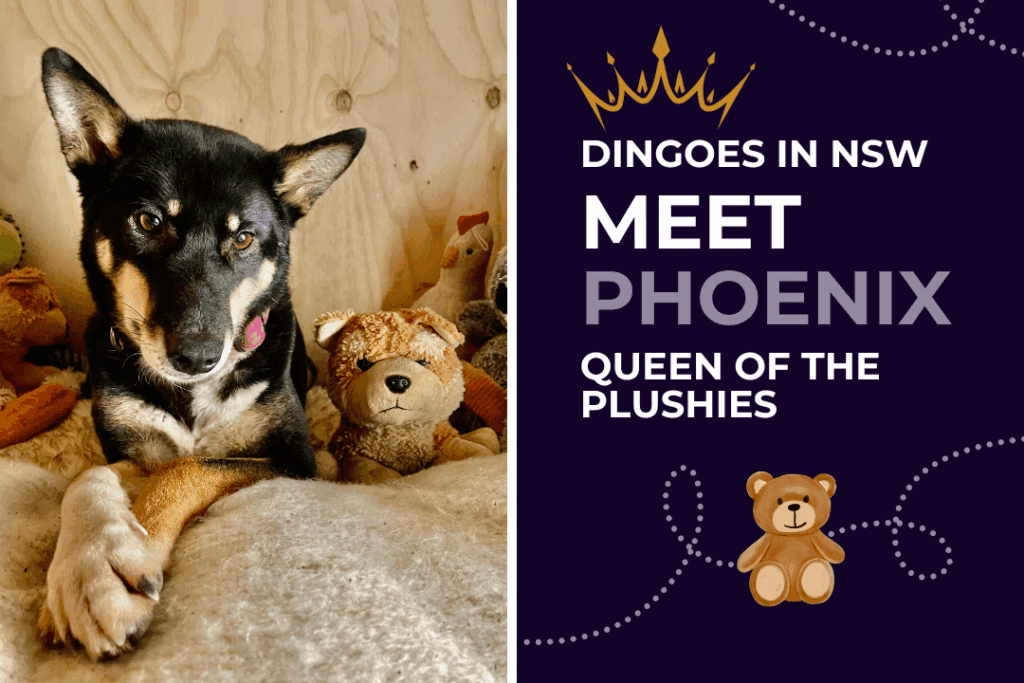
Rescue dingoes in NSW: Meet Phoenix
Hi Lisa! You adopted Phoenix when Pho was three years old. What type of dingo is Pho?
Phoenix is an eastern coastal dingo (used to be referred to as a tropical dingo). You’ll notice that Pho is a black dingo — dingoes can be black. Her dark colouring helps her blend into forested areas.
Eastern coastal dingoes live in the coastal areas east of the Great Diving Range, from Wollongong in the south, right up to the northern tip of Australia. Living near farmland, eastern coastal dingoes are heavily persecuted.
Phoenix’s origin story
Can you tell me about Pho’s early years?
Pho was found wandering across a driveway on a farm near Cessnock, Hunter Valley, NSW. She was estimated to be about three to four weeks old, as her eyes were not yet fully open, and her ears were still partially flopped. She was severely malnourished and covered in ticks.
Pho had clearly been wandering around for a few days without either of her parents’ care. It is assumed that her parents were killed, as the shooting and baiting of dingoes is common in the area. Due to the lack of her mother’s nurture at such an early stage of her development, Pho is very small for a dingo. This, in combination with the ticks that covered her eyes, has resulted in Pho being partially blind.
The cattle farmer who found Pho took her into their home. For a few weeks Pho stayed in their house, sleeping in their laundry at night. Once she gained size and strength, she was allowed out into the dog yard with the farm dogs. Pho behaved very differently to the farm dogs — she was very independent and preferred her own company. They named her Missy due to her headstrong attitude. Her name changed to Phoenix when she arrived at the rescue.
Once she was used to the freedom of the dog yard, Pho became more reluctant to have any contact with the farmer and his wife. Realising they couldn’t meet her needs, they made the choice to surrender her to a dingo rescue when she was about three months old.
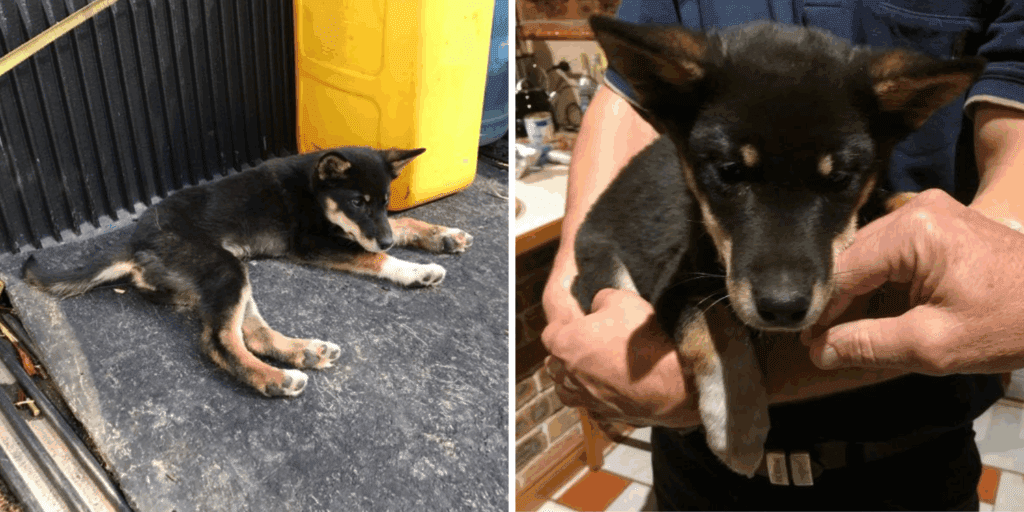
Finding Pho
How did you end up adopting Phoenix? Can you tell me about your early days with Pho?
Growing up, our family had a dingo, Vixen, as a pet. When my own family had grown up and didn’t need mum so much, I chose to reestablish contact with dingoes and volunteer at a rescue. It was there that I met Pho. Pho had been a resident for about two and half years.
I would like to share some thoughts on dingo rescues. Dingoes are designed to live in the wild in family units with a very strict hierarchy. Dingoes generally do not thrive in an environment where unrelated dingoes are forced together in small spaces in captivity. This creates an unnatural, highly competitive environment where dingoes have to fight for everything, including their very survival. The majority of dingoes, like Pho, do not thrive in this environment.
Due to her blindness and her naturally timid nature, Pho was overlooked for adoption as a puppy. Once she outgrew the puppy pens, she was placed with the older dingoes. Pho was the weakest dingo there. Unfortunately, due to a dingo’s inherent drive to survive, Pho became the scapegoat at the bottom of the pack and was repeatedly picked on. Pho eventually needed to be segregated from the other dingoes in order to save her life.
When I started volunteering at the rescue, Pho had been segregated for about two years. She lived in a small area at the rescue with the other dingoes constantly harassing her along her fence line. Autumn was approaching, which is the start of dingoes’ annual breeding season.
At this time, dingoes are valiantly fighting for their place in the pack hierarchy. My heart broke when I saw how this affected Pho. She did not belong. She shied away from contact with humans and appeared to have no meaningful bond with her own kind. She was emotionally broken and disconnected. I chose to adopt her as I hated seeing her kept under these conditions even though I had yet to touch her. I hoped that in her own space, her individual needs could be better met and we could bond.
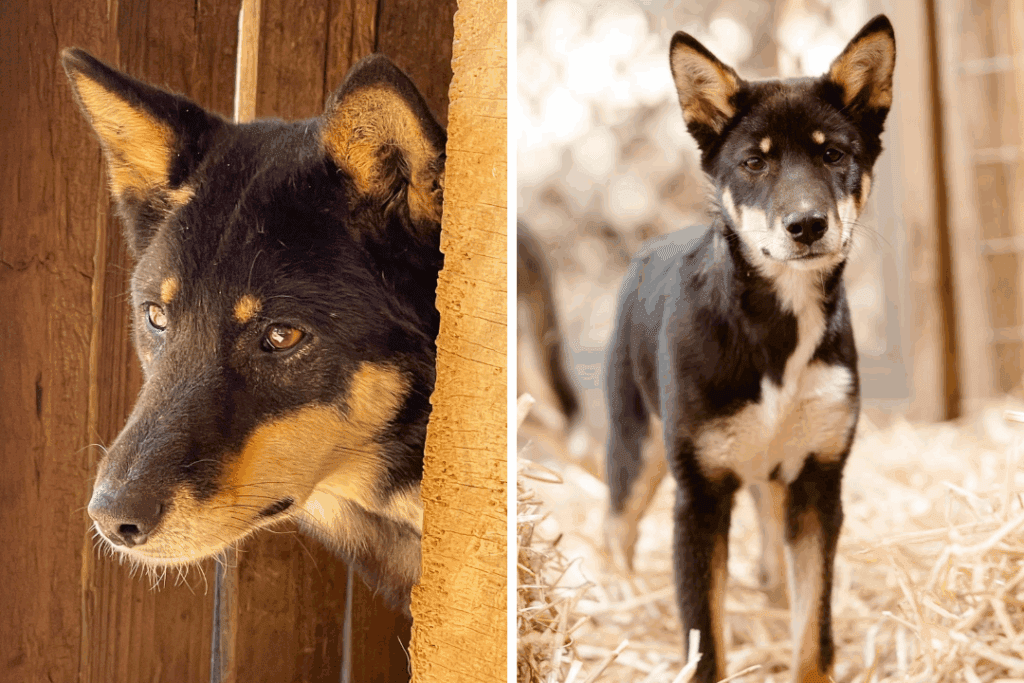
Making a home for Pho: building a safe dingo enclosure
I had known Pho for six months before she arrived here. Most of our work in adopting Pho came before she arrived. Given her incredibly shy nature, we could not expect Pho to cope living in the house with us, so we built her an enclosure with a yard and her own little house. A lot of thought went into designing this. We knew that Pho was very independent and would prefer us at a distance. We needed to make the yard enticing to her to draw her out, while having a fence line through which she could safely get to know and interact with us.
Initially we only entered Pho’s enclosure to feed, clean, and water her garden. It took many weeks for Pho to get used to our presence. Eventually, Pho would come out into her yard while we were in it, especially when we were watering the garden. She loved to run through the water drops from the hose.
Over time, we gradually got closer to Pho. Our rule interacting with her is to always remain within her comfort zone. Whenever she shows signs of distress, we back off, and leave. As her trust in us built, we were able to sit in her den with her, eventually leading to head pats, back pats and chest scratches. We have a strong focus on regularly practicing the type of activities that the vet would do — such as wearing a muzzle, checking her eyes and ears and touching her chest/tummy to listen to her heartbeat. When she needs the vet, the vet visits her at home.
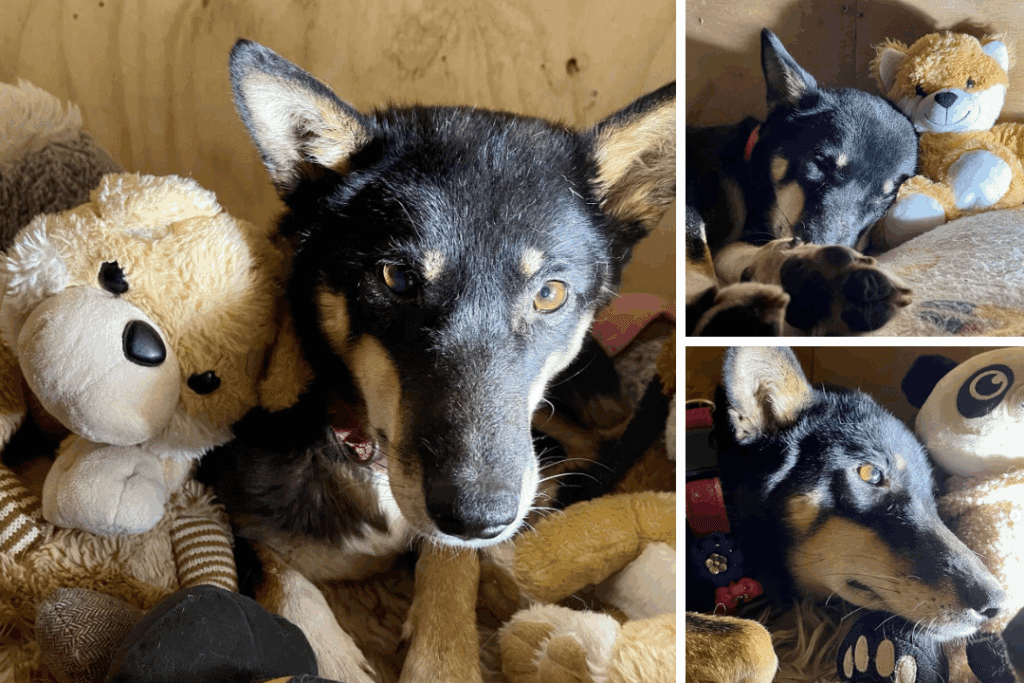
Dingo cameras
Your dingo cams are a joy to watch. I noticed Pho really loves her stuffies, which is such a contrast to our dingoes. Can you tell me more about Pho and her stuffies and why she tends to them so carefully?
We learned very early on that Pho is obsessed with stuffed toys. She initially only had two, a brown bear and an orange fox. Pho would care for her two babies very tenderly, nuzzling them and cuddling up to them at night. I had assumed that they were proxies for her siblings.
Seeing Pho’s affection for her two toys, I gave her a whole lot of my old stuffies and over time she has amassed a substantial collection. She loves to select special ones to take out into the yard. She likes to throw them around and shake them. She especially loves to run holding them in her mouth and she will then dig holes and lay them on the fresh earth. She picks which ones are her sleeping companions in her den and arranges them in a circle in which she sleeps. In the nearly four years that we have had Pho, she has not destroyed a single stuffed toy! Not a single one!!!
After her companion, Noah, arrived, in the next breeding season that followed, Pho built a hollowed out nest under her deck. She then started taking some of her toys out there. She would sit out in the nest with them, protecting them. She would even bring them bones to eat. Noah eventually joined in, with Pho taking the day shift, and Noah the night shift. Even though both dingoes are desexed, the decreasing levels of light as winter approaches sets off their hormones and their instincts to breed kick in.
I recently did some research on Pho’s early life, and interviewed the farmer who found her. I found out that they had given her a stuffed toy to keep her company. I believe her time on the farm was a relatively happy time for her as she recovered from the trauma of losing her family. There are two things that Pho absolutely loves — beef steak and stuffies. Both of these things hark back to her time living on the cattle farm and bring her solace.
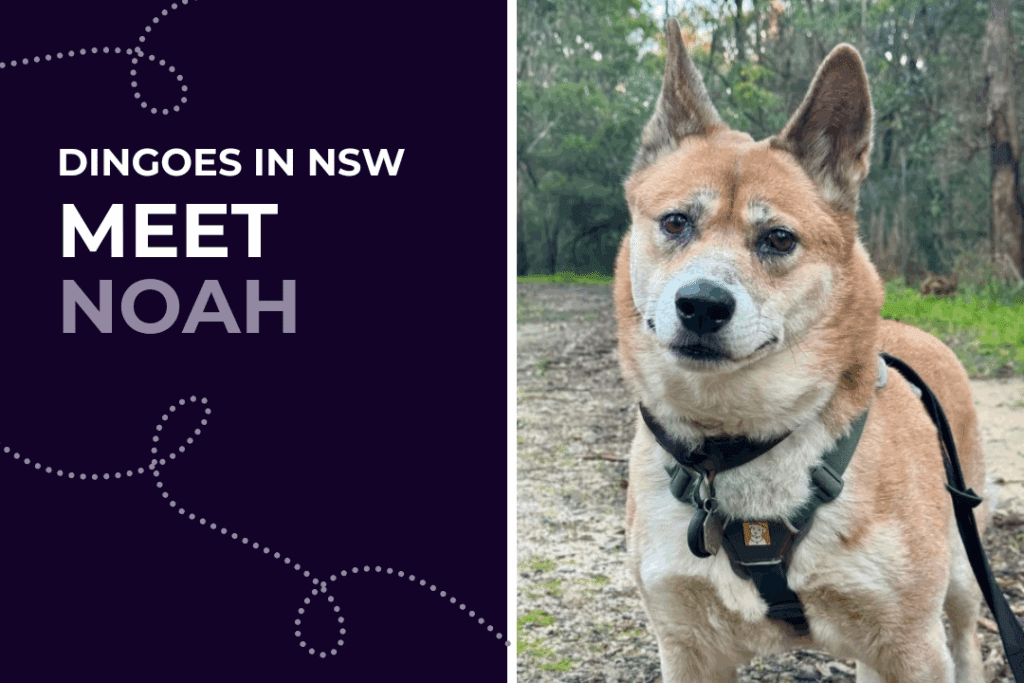
Rescue dingoes in NSW: Meet Noah
Noah was almost seven when you adopted him. What type of dingo is Noah and what’s his origin story?
Noah is an Alpine Dingo, who was bred in captivity by a dingo breeder. As is the case with a lot of dingoes born in NSW in captivity, he was placed in a home which was unprepared to meet his needs as a dingo. He kept escaping, terrorising the local chickens. A dingo rescue was called in to capture him. He managed to evade their efforts for five nights before finally being caught. His owner refused to take him back.
Noah was about a year old when he arrived at his rescue. He lived at the rescue for six years, an extraordinarily long time, however not uncommon at dingo rescues. When he arrived here, he was an incredibly compliant dingo with no independent thinking. He simply obeyed instructions. It took about a year for Noah to settle and for his personality to emerge.
Finding a dingo companion for Pho
You adopted Noah from the dingo rescue the year after Pho. Why did you choose Noah and what is their relationship like?
When we were looking for a companion for Pho, we were looking for a male dingo with a gentle, non-dominant personality. We didn’t want Pho to face constant harassment like she did at her rescue.

Pho interviewed three eligible bachelors. Noah, although he was older than what we were looking for, was the standout. Upon meeting Pho, Noah instantly recognised that she needed to have her boundaries respected. He sat at the furthest end of her den, away from her, and waited for her to adjust to his presence. When he could sense that she was comfortable, he would wriggle a little bit closer and start the process again. Eventually, he got close enough that they were able to give each other a thorough sniff inspection. Both were very interested in the other. They met twice before he moved in for a two-week trial.
What is Noah’s personality like and how does this come across on a day to day basis?
Noah’s personality is quite timid and fearful, while being an absolute goof.
When he arrived Noah spent the first six months hiding in his den only emerging to walk. Like Pho, Noah arrived here with his own trauma. Six years is a long time to spend having to conform to group rules and to experience constantly changing companions. It took over six months for Noah to start feeling comfortable with me handling him and to form a bond, which was longer than it took Pho.
Pho and Noah’s early days as dingo companions
We believe Pho was happy to have a dingo companion, however, she made it very clear from the very first day that she was not sharing her den with Noah. Noah has the choice of our other two dens to sleep in.
Pho and Noah have a very complex relationship. Both have experienced significant trauma that they need to overcome on their own. Their own personal struggles have slowed down the progress of their relationship.
When Noah arrived, he was quite dominant over Pho in relation to food. We needed to feed them separately for quite some time until Noah realised that food was plentiful. Pho was initially quite wary of Noah because of this.
Noah learnt very quickly that athletically he was unable to compete with Pho. Pho has a very slender, lithe build, while Noah is rather podgy. Pho literally ran circles around Noah and has been known, on occasion, to jump over his head.
Noah and Pho, two years on

They’ve been together for two years now, and although it may not be a physically affectionate relationship, it is a very comfortable one. I find it very difficult to tell who is the dominant one, but I suspect that it’s Pho, although she lets Noah think it’s him.
Pho can be very devious. When Noah hides his bone in the yard, Pho loves to torment him by letting him think she is about to steal it. She also regularly raids his bed while he is off on his walk and will steal anything that takes her fancy, in particular, his stuffed toys. The fear that Pho used to have around Noah has now vanished. They are very comfortable hanging out in the yard together, although they tend to do their own individual things, coming together randomly.
One activity that they are very united on is breeding season. Each year, as the nights start to cool, Pho and Noah start marking the yard, leaving messages, which the other replies to. They are both very keen to read the other’s reply and spend a lot of time standing in the vicinity of the other, conducting sniff inspections. Then the nest building begins and the stuffed toys arrive.
This breeding season has been a particularly wet one. When it rains, they both go out into the yard and excavate around the nest to ensure that the water stays away.
Dingo walks with Noah
We took Noah on walks from his first days with us, and initially he absolutely hated his walks. Noah was very fearful of his new surroundings and was especially terrified of strangers. Walks became a mission to avoid people.
We usually start walking just before sunrise. We keep to bushland, usually doing secluded out-of-the-way trails. Being an alpine dingo, Noah has a triple coat, which can be very uncomfortable in summer. Summer walks are usually based around creeks or rivers.
Noah now lives for his daily walk, but it was quite the process to establish that. On one of our early walks, we met Matt and his kelpie Pippa. They offered to join us on our walks a few times a week so Pippa could show Noah ropes and instil confidence in him. They are now besties.

One thing I noticed while walking Noah — he is very responsive to the emotions of people approaching. Humans attached to dogs tend to be no worries.
Humans without dogs, are a different story, particularly where the human is fearful of dogs. I find that I often need to talk to approaching humans, to calm them, in order to keep Noah settled.
In the early days meeting another human would signal the end of the walk and the need to carry Noah, no matter how far, back to the car (having a harness with a back handle was a god send).
Now we usually survive these encounters unscathed and Noah is happy to continue on his walks.
Noah loves nothing more than to find a scent and then travel off-road following it. We do rambles often in the winter months.
For a dingo, who is meant to have highly developed skills for survival, Noah is a bit of a misfit. During our walks, it’s not uncommon for him to walk off cliffs, jump into strong river currents, and stick his head down any hole. He has no sense of self-preservation. That said he is highly aware of snakes and keeps his distance.
Dingoes are known for being quite aloof. Is Noah a social dingo?
For a dingo, Noah can be incredibly social, when he is comfortable. Noah ventures into our house, on occasion, and loves hanging with our cats and our little dogs. For a dingo, Noah has an unusually low prey drive. He also braves the dog park, which is his happy place, playing with his doggy friends. He interacts in small bursts of play, then takes a break doing his own thing, before returning for more play. It did take some time, but he has formed exceptionally close bonds with some of the humans there. It is an absolute joy to watch him bounding towards one of his human friends, who is waiting for him with their arms stretched.
Noah is quite goofy in play at the dog park. He tends to play with his front arms failing around. He can pick the pace up when he is running towards a human at full pelt, veering off at the last second once he knows he was successful in frightening them.
One thing Noah does at the dog park is poo roll. He started to do this after a few unpleasant incidents with other dogs. Dingoes do not have scent glands like dogs and their lack of smell can be off putting to some dogs. Noah learnt early on that if he acquired a dog’s scent, other dogs will leave him in peace.
At the dog park, he is well known for going up to humans demanding butt scratches, and we all know to check him for poo before handling!!
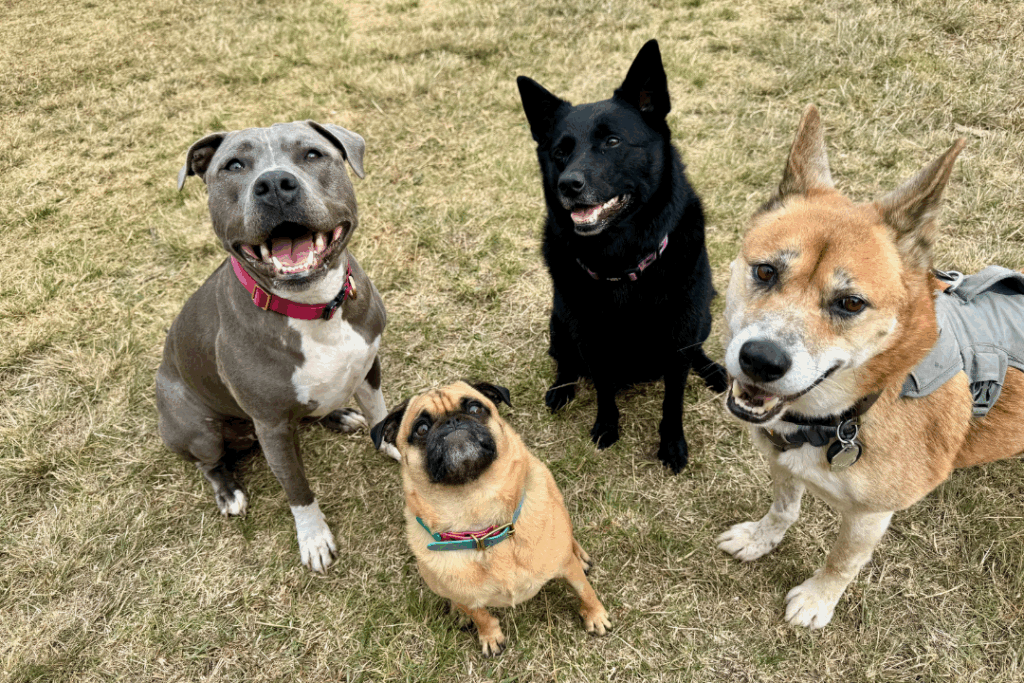
Adopting dingoes in NSW: Meet dingo guardian, Lisa
Where are you based in NSW and can you tell me about who else cares for your dingoes in your home?
We are located in suburbia in North West Sydney. Myself and my husband, both in our 50s, are the caretakers of our two dingoes. I tend to be home a lot of the time.
Both of your dingoes spent several years at a dingo rescue, three years for Pho and six for Noah. How does this affect their relationship with you and your family and how do you accommodate their preferences and behaviour?
Being at a rescue has had a profound effect on each of our dingoes. Neither was suited to the rescue lifestyle, occupying low ranking positions within their packs and struggling to form relationships with their carers.
When Pho arrived here, she had spent two years in a very confined area, with very little opportunity for exercise. She was very uncoordinated — her feet kept slipping out from under her. She was so excited to have her very own yard to play in, that she persisted, and with time her muscles recovered. We maintained the raw food diet that she had been on and added lots of supplements to assist with recovery of her skin, fur and strength.
Noah has a fear of men and has taken much longer to bond with dad. Noah was very regimented. It took a very long time for him to relax and discover that he could make his own choices. Noah struggled with his diet when he arrived here. Rescues rely solely on donations from members of the public and businesses. Food will be one of their major bills and is often the one skimped on during tough times. Noah had not had a diet as varied as Pho’s. There were a few tummy issues as he settled in and adjusted.

We have taken time to get to know our dingoes individually, to give them space and time to work through their trauma. One thing we find particularly important is keeping to a routine and being fairly predictable.
As it is harder to spend individual time with Pho, it’s important to have little routines with her. Interactions tend to be short but plentiful. Whenever we are out in our yard and she is in her enclosure, we always approach the fence line and so she can sniff our hands. She always likes to come out to greet us when we arrive home, and again, we offer her our hands so she can sniff. We make a big effort to eat as many of our meals as we can outside so that she has opportunities to interact with us.
Having a very secure dingo enclosure, that is entirely separate from our house, means that we do not have to worry about them quite as much as they are in a safe space where their ability to interact with others is limited. They can do their own thing without interference. They both enjoy their own company. We also have the dingo cameras so we can keep a close eye on them when they are in their dens or chilling under the deck.
They do keep quite different routines. Pho constantly has little naps, followed by play sessions. So she is often out and about, playing in her yard both day and night. Noah on the other hand, when he returns from his walk, remains in his den all day, not emerging to go into the garden until it is dark.

We provide them with enrichment activities every day. For example, Noah is very serious about his meals and gets his dinner in a bowl and his den. Pho likes hers to be a game where we scatter it around the yard for her to find.
Pho is quite happy playing on her own: with her stuffies, digging holes, running around the yard and curling up in the sun. She pretty much entertains herself. Noah is less active, preferring minimum effort activities (like simple puzzle boxes with treats) and likes his interactions to end with pats, cuddles or food rewards.
What steps did you take to help them become comfortable in their new home in suburbia?
Lots of patience. Basically, listening to their body language, their cues, and adjusting our actions to suit. Just because you could do an activity with Pho one day does not mean that you can do it the next.
Both dingoes had lived in suburbia previously, Pho at her rescue and Noah with his first owner. There were no big issues there. Neither are big howlers. We have yet to even hear Noah howl.
We are very careful about who we let into our backyard. Any visitor to the dingo enclosure is always fully escorted, and the length of the visit depends on the dingoes’ reactions. Noah will never exit his den when anyone is in the backyard, but Pho is more curious and likes to come out and observe.
Being partially blind, Pho needs to be handled with extra care. From observation, her short vision is affected more than her long distance. When entering her enclosure, we always take our time and wait at the gates till she recognises that we are entering. When she’s nearby, we make very slow, careful movements so that she can follow along.
Dingoes can be quite anxious on walks, can you tell me about Pho and Noah’s exercise?
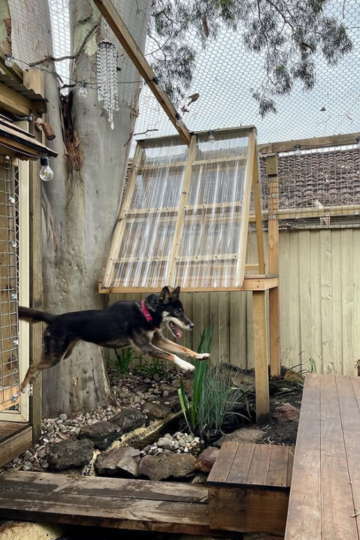
Pho does not go on walks. These would be too traumatic for her. We are hoping that one day she may be able to come out on a lead to explore our side or front yard, but doubt she will ever do public walks. We have spent lots of time getting her used to our close presence, getting a collar and a harness on her.
Our biggest stumbling block is that she is happy to be close to us while we are seated, but this isn’t the case when we are standing. It would be very difficult to walk her if she was constantly trying to get away from us. We had hoped that Noah’s example may encourage her. As yet it is still a work in progress.
As I have said, Pho is up and down all day and night, but she is most active at dawn and dusk, where she will normally play very enthusiastically for an hour or two. She particularly likes her alone time to run and jump when Noah is on his walk.
Pho’s favourite time of the day is when her dad comes home. She and our two dogs get very excited and get an attack of the zoomies. Pho is particularly affected by the new moon and her athletic abilities heighten. It is amazing to watch her jumping skills and to enjoy how much she has developed and thrived since arriving here.
A few weeks ago one of our dogs passed from cancer. Although Pho had only interacted through the fence with Ike, she was visibly distressed at his passing and for many days afterwards hung at the fence line watching and waiting for him. She did not sleep until we placed some of Ike’s toys covered in his scent with her.
We walk Noah at dawn each day. We normally drive to park or bushland areas, plus he gets a play date one morning each week at the dog park with his buddies. Walks can last from an hour to 2 1/2 hours. The focus on walks is not about exercise, covering a given distance or taking a set route. It is all about the adventure — exploring, stopping to take in the different scents, watching the roos or rolling in deer poo. There’s a lot of stopping and starting. It is as much a spiritual, mental experience as it is a physical one.
During our walks, Noah still has fearful moments and we work together to overcome these. Noah is always particularly reluctant to walk in areas where paths cross because he knows he is more likely to run into people. He still has occasional total meltdowns on walks. Like most dingo owners, I ask myself at least once each walk “Why did I get a dingo?”. And then we find a puddle and he becomes very playful or we sit on a hill and sit together, enjoying an amazing view with cuddles, and butt scratches, and I remember why.
Noah loves water walks and we try to drive the distance regularly to the river or beach. He absolutely adores the beach and has no fear running in and out of the waves.
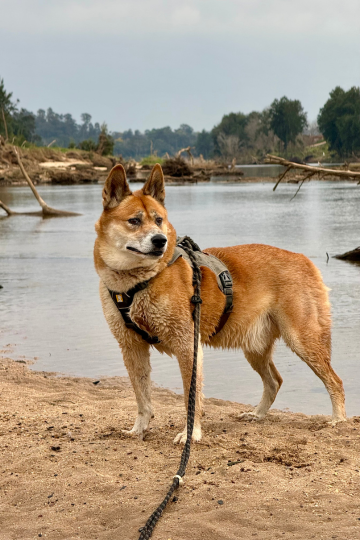
Noah is getting older, with his 10th birthday fast approaching. We are starting to slow down the walks a little bit and not do so many long ones.
Dingoes are very skilled at escaping from collars and harnesses. Which harnesses do you prefer using for your dingoes?
We use a triple strap harness from Ruffwear (Web Master harness). Whenever I walk Noah, I thread two leads through the handle on his harness. One attaches to the harness itself, the other to his collar.
Noah likes to roll an awful lot and explore tunnels, resulting in much rubbing on his back. Every so often his harness lead will unclip.
The second lead attached to his collar keeps everything safe, as threading the lead through his harness makes it difficult for him to slip his collar.
When Noah visits the beach or river, we also use a special order biothane lead, specially designed in conjunction with Kim & Milly’s Cords 4 Paws. This lead has an intricate design, ensuring that every juncture has a double support while not becoming waterlogged.
Building Pho and Noah’s dingo enclosure
Your dingo enclosure is quite the fortress — very necessary with dingoes, but yours is even more secure. Can you tell me more about how it’s built and what you’ve incorporated into it for their enrichment and safety?
Our enclosure was designed with Pho’s special needs in mind. Pho needed a space that was just hers, while still having access to us at a distance. We needed to make sure that she was safe, as well as considering our recently arrived acrobatic kitten, who could climb anything, plus the neighbouring cats who regularly visit our yard. There are no rules in NSW regarding dingo enclosures, however we made sure that we complied with the Victorian regulations. The enclosure covers half of our back yard, approximately 65 m².
We first excavated the yard area. We dug down a depth of one metre and added a wire barrier on the floor. This allows Pho to dig while preventing escape. We installed wire walls that extended from this floor to rise at least 2.4 metres above the ground. We then returned the dirt and added a pond. We installed a wire roof to ensure cats were kept out.

Central to the yard is a large deck. This deck also extends around part of the fence line, creating both a seat and a tunnel. The decking was added for two reasons. Firstly, to maximise the space, allowing Pho to play both underneath and on top. Secondly, being very timid, we needed to give Pho safe places to hide. Around the side of the deck are walls with lots of doorways, allowing Pho lots of points of entry and exit.
We made sure that her garden was very enriching. There is a pond with a little stream, a waterfall, and a bridge. She has a shaded rock garden hidden behind a gum tree. There are two digging pits to provide different textures, one filled with dirt, one with sand. We also installed lots of native plants, herbs and grasses to attract wildlife as well as adding fragrance to the area. Two large gum trees tower over the enclosure, providing much needed shade. We also provided some agility objects for her such as jumps, a long run around the pool and a treehouse to watch the world from.
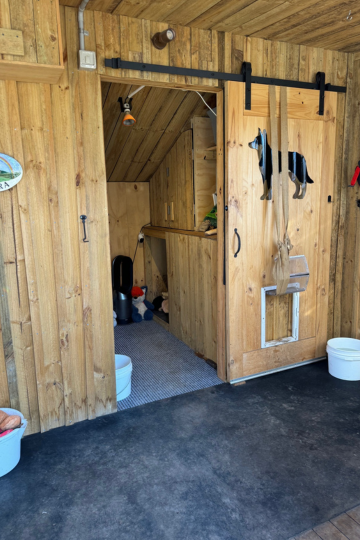
A very big factor in designing her enclosure was to make sure that Pho was immersed in nature. At her rescue she had lived on a concrete floor, which she never left. She was disconnected from the earth and hadn’t received adequate exercise.
Given that it is very unlikely that she will ever be able to be walked in public, we needed to create a space where she would feel inclined to exercise herself.
She loves running around her enclosure, and, as her strength built, challenging herself to do amazing jumps.
There’s lots of wildlife in her enclosure. The gum trees attract many birds and bats. Lizards and frogs live in the greenery, and the flowers draw in lots of butterflies.
Pho was given her own house. The front portion is a veranda to allow for wet weather play. The rear contains three dens and a cupboard for storage. To ensure there is adequate airflow in summer, we have a fully barricaded window that we can open, and air vents in the floor.
We added fans to circulate the air, and in winter we rely on a reptile heater to take the sting of the cold out of the air.
Pho’s den was built to the exact measurements of the one at her rescue so that it would be familiar to her. When she first arrived, she was used to sleeping on a hard surface. It took quite some time to get her used to blankets and mattresses. Noah had no such issues.
For security to get in and out of the enclosure, we have two gates with an interconnected airlock. As dingoes have amazing abilities to turn handles and undo bolts, all of our gates are fitted with four latches — one side has three (high, middle, and low) with the other side having one in the middle. All gates are self-closing and latching. To be doubly safe, we have also dingo-proofed our whole backyard, so if they do get out of their enclosure, they are then trapped in the yard. We do regular checks and perform maintenance on the fence lines. Should we ever need to segregate the dingoes, the enclosure can be divided into four areas, the house, the veranda, the yard and the dingo run.
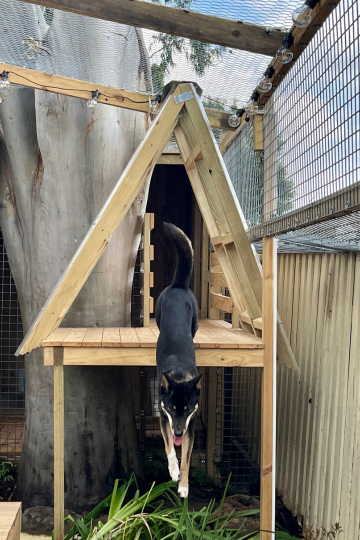
The enclosure extends the full length of our back yard. The vantage points in the enclosure allow Pho to look into our house to track our movements.
We also aim to spend as much time as we can in our outdoor entertaining area so that Pho can be with us through the fence. This set up allowed Pho to get used to us in a very non-threatening way.
We live with two small yappy dogs and three cats. Being wild-born, Pho may see them as prey. They all interact with Pho through the fence.
She has a very playful relationship with our kitten. They play paws through the fence and our kitty will run on the wire roof while Pho runs below.
One of our dogs was also very close with Pho. He was a very good protector of our yard and would let Pho know when any danger was approaching. When he barked, she would come out of her house and they waited together for the danger to pass. They also liked to play zoomies together, each running on their side of the fence.
Cameras were added so that we could observe Pho and get to know her and to check on her without being in her space. Both have tracking devices on their collars.
Adopting dingoes in NSW
What advice do you have for people adopting a rescue dingo in NSW?
When it comes to pet ownership In NSW, dingoes are treated the same as dogs. This is both a blessing and a curse. There is currently a push to have this changed.

When it comes to pet ownership In NSW, dingoes are treated the same as dogs. This is both a blessing and a curse. There is currently a push to have this changed. Owning dingoes is definitely not for everyone. However, if you have the patience and are prepared to adapt to their quirks, it is one of the most rewarding relationships that you can ever experience.
The majority of dingoes living in captivity have suffered some form of trauma. Earning their trust is a painstaking process. For a dingo guardian, it is about being predictable and safe. It is only when they are not stressed that they can learn to interact in a confident and happy way. It is about learning their boundaries, through their body language, and respecting them. It is about being their anchor in a world that can feel very unsafe. It is about discovering their interests and encouraging them, teaching them to explore happiness and joy.
Dingoes are unlike dogs in that they do not automatically like and trust you. These have to be earned. The relationship needs to be regularly worked on and maintained. One cross moment at a dingo can annihilate any relationship that you have built and you need to start again. People who cannot control their emotions, or are loud expressive people, will struggle with a dingo.
Are there any specific dingo rescues you recommend?
If you are considering adopting, look at Noah’s Rescue, Sydney Fox and Dingo Rescue (SFDR) located near Goulburn. When Pho arrived here her rescue ceased providing any post-adoption assistance almost immediately.
Although Pho was not one of theirs, Charlie (Founder of SFDR) and her team accepted Pho as though she was. They provided post adoption support for her, offering guidance whenever it was requested.
I also loved that Noah’s adoption contract contained conditions as to the standard of care that we were expected to provide for him and that if we ever found ourselves in a position needing to relinquish him, that we were to approach them first. They also offer a trial period. In contrast Pho’s paperwork simply said nonreturnable or nonrefundable. It is so important to have adequate support when adopting the unique creature that dingoes are.
You need a network helping you as you navigate the challenges to give you different perspectives to consider. As they are so unlike dogs, you need someone who understands the dingo mindset.
Sydney Fox and Dingo Rescue is also one of the few rescues that will accept any dingo in any condition that most other rescue organisations reject — dingoes with substantial injuries, older dingoes etc. (although, since Covid, like many rescues, they are currently full). They have so many deserving dingoes to choose from.
Is there anything you’d like to add?
At dingo rescues there are lots of dingoes like Pho, the timid ones, who are considered unadoptable. Most will live their lives out at rescues and never know the joy of a home and a family of their own. It breaks my heart to see this. So please financially support dingo rescues as they do a thankless unseen job caring for these precious souls.
If you are dingo savvy, when looking for a dingo, ask about the shy ones who need more patience. They will reward you many times over as you watch them settle and open up. They just need a safe, quiet place in which to live. In all honesty, now she is settled, Pho is so easy to look after as she is at her happiest being left alone to do her own thing. So long as she is connected with nature and gets some company, whether that is from us, Noah, our pets, or the visiting wildlife, all is good.
Also, a dingo’s diet is super important and makes a huge difference to their overall health.
Sending sincere gratitude to Lisa for sharing Pho and Noah’s story. Learn more about Phoenix and Noah, and watch their dingo cameras on Instagram @raising.phoenix.dingo.
Frequently Asked Questions
Is it legal to adopt dingoes in NSW? Currently, yes, it is legal to adopt a dingo in NSW.
Where can I adopt a dingo in NSW? Try Sydney Fox and Dingo Rescue (SFDR), who are located in Goulburn, between Sydney and Canberra. At the time of publishing SFDR was home to 103 rescue dingoes, who cannot be released into the wild — consider adopting a dingo today.
Where can I buy a dingo pup? Please consider adopting rather than buying a dingo from a dingo breeder. Your local dingo rescue is likely to have many adult dingoes in need of a home and at times, dingo pups/cubs.
How high should my fences be if I adopt a dingo? Fences should be at least 2m high, or 1.8m with a 45 degree return, leaning inwards, to prevent escape. If you live in Victoria, there are specific laws and regulations related to dingo enclosures and fencing.
What do dingoes eat? Dingoes primarily eat raw, lean meat. Click here for an extensive guide on dingo diets.
Where do dingoes sleep? Rescue dingoes can sleep indoors or outdoors. Some dingoes, like Pho and Noah, live in outdoor enclosures with adequate ventilation, shelter and heating. Our dingoes, Rusty and Jalba, primarily sleep indoors on their bunk bed or dog bed, but they also love to sleep in any quiet corner indoors. In warm or hot weather, they love sleeping outside on the warm sand or pavement.
How can I help if I can’t adopt a dingo? You can donate funds, time or supplies to dingo rescues such as Sydney Fox and Dingo Rescue.
Tags: Dingo Adoption


0 Comments